Grantee Research Project Results
2009 Progress Report: Project 3 -- Inhalation Exposure Assessment of San Joaquin Valley Aerosol
EPA Grant Number: R832414C003Subproject: this is subproject number 003 , established and managed by the Center Director under grant R832414
(EPA does not fund or establish subprojects; EPA awards and manages the overall grant for this center).
Center: UC Davis Center for Children's Environmental Health and Disease Prevention
Center Director: Van de Water, Judith
Title: Project 3 -- Inhalation Exposure Assessment of San Joaquin Valley Aerosol
Investigators: Pinkerton, Kent E. , Kleeman, Michael J. , Bonham, Ann
Current Investigators: Pinkerton, Kent E. , Kleeman, Michael J.
Institution: University of California - Davis
EPA Project Officer: Chung, Serena
Project Period: October 1, 2005 through September 30, 2010 (Extended to September 30, 2011)
Project Period Covered by this Report: July 1, 2008 through June 30,2009
RFA: Particulate Matter Research Centers (2004) RFA Text | Recipients Lists
Research Category: Human Health , Air
Objective:
Epidemiological evidence suggests that the association between cardiac mortality and PM 10 concentrations changes between the summer and winter months in the San Joaquin Valley (SJV). This shift is likely caused by seasonal variation in the size and composition distribution of airborne particles. This project will perform inhalation exposure and particle characterization studies at rural and urban locations in different seasons to quantify the features of the airborne particles that are associated with adverse health effectsProgress Summary:
|
|
|
|
|
|
|
|
|
|
|
|
Fresno
|
West Side
|
||||||
|
|
Summer
|
Winter
|
Summer
|
Winter
|
||||
|
|
Week 1
|
Week 2
|
Week 1
|
Week 2
|
Week 1
|
Week 2
|
Week 1
|
Week 2
|
|
RAAS (ug/m3)
|
18.551
|
21.245
|
23.667
|
10.981
|
7.542
|
11.523
|
15.389
|
14.736
|
|
CAPS (ug/m3)
|
207.222
|
360.556
|
129.630
|
97.222
|
106.481
|
145.370
|
88.889
|
82.407
|
|
Concentration Factor
|
11.170
|
16.971
|
5.477
|
8.853
|
14.119
|
12.616
|
5.776
|
5.592
|
|
|
|
|
|
|
|
|
|
|
|
|
|
|
|
|
|
|
|
|
|
|
|
|
|
|
|
|
|
|
|
Sampling Volume
|
|
|
|
|
|
|
||
|
Andersen Volume
|
18
|
m3
|
|
|
|
|
|
|
|
Concentrator Volume
|
1.08
|
m3
|
|
|
|
|
|
|
|
|
|
|
|
|
|
|
|
|
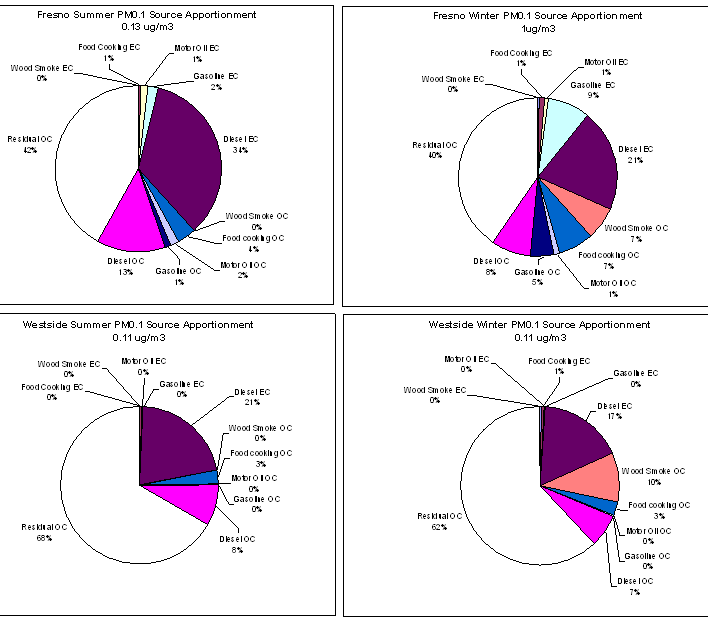

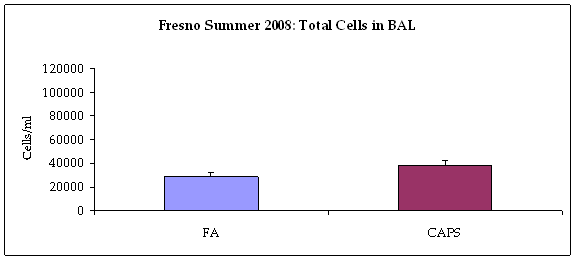
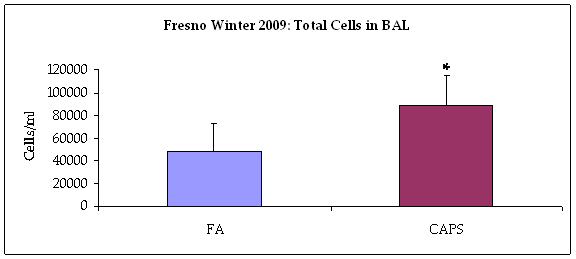



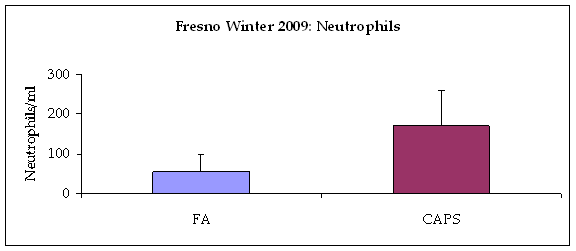
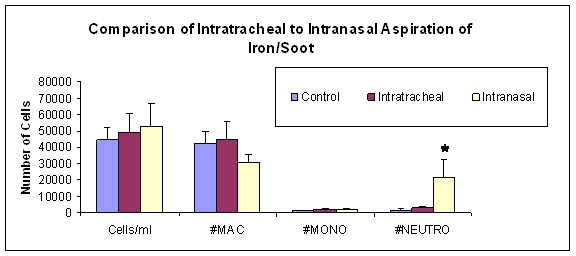
Future Activities:
Journal Articles on this Report : 8 Displayed | Download in RIS Format
| Other subproject views: | All 28 publications | 21 publications in selected types | All 17 journal articles |
|---|---|---|---|
| Other center views: | All 128 publications | 71 publications in selected types | All 64 journal articles |
| Type | Citation | ||
|---|---|---|---|
|
|
Donaldson K, Borm PJA, Oberdorster G, Pinkerton KE, Stone V, Tran CL. Concordance between in vitro and in vivo dosimetry in the proinflammatory effects of low-toxicity, low-solubility particles: the key role of the proximal alveolar region. Inhalation Toxicology 2008;20(1):53-62. |
R832414 (Final) R832414C003 (2008) R832414C003 (2009) R832414C003 (Final) R829215 (Final) |
Exit Exit |
|
|
Kleeman MJ, Riddle SG, Jakober CA. Size distribution of particle-phase molecular markers during a severe winter pollution episode. Environmental Science & Technology 2008;42(17):6469-6475. |
R832414 (2009) R832414C003 (2008) R832414C003 (2009) R832414C003 (Final) |
Exit |
|
|
Kleeman MJ, Riddle SG, Robert MA, Jakober CA, Fine PM, Hays MD, Schauer JJ, Hannigan MP. Source apportionment of fine (PM1.8) and ultrafine (PM0.1) airborne particulate matter during a severe winter pollution episode. Environmental Science & Technology 2009;43(2):272-279. |
R832414 (2010) R832414C003 (2009) R832414C003 (2010) R832414C003 (Final) |
Exit |
|
|
Madl AK, Pinkerton KE. Health effects of inhaled engineered and incidental nanoparticles. Critical Reviews in Toxicology 2009;39(8):629-658. |
R832414 (2010) R832414C003 (2009) R832414C003 (2010) R832414C003 (Final) R829215 (Final) R831714 (2005) |
Exit |
|
|
Pham H, Bonham AC, Pinkerton KE, Chen CY. Central neuroplasticity and decreased heart rate variability after particulate matter exposure in mice. Environmental Health Perspectives 2009;117(9):1448-1453. |
R832414 (2010) R832414C003 (2009) R832414C003 (2010) R832414C003 (Final) R831918 (Final) |
|
|
|
Riddle SG, Robert MA, Jakober CA, Hannigan MP, Kleeman MJ. Size-resolved source apportionment of airborne particle mass in a roadside environment. Environmental Science & Technology 2008;42(17):6580-6586. |
R832414 (2009) R832414 (Final) R832414C003 (2008) R832414C003 (2009) R832414C003 (Final) |
Exit Exit Exit |
|
|
Schenker MB, Pinkerton KE, Mitchell D, Vallyathan V, Elvine-Kreis B, Green FHY. Pneumoconiosis from agricultural dust exposure among young California farmworkers. Environmental Health Perspectives 2009;117(6):988-994. |
R832414 (2010) R832414C003 (2009) R832414C003 (2010) R832414C003 (Final) R826246 (Final) |
|
|
|
Wegesser TC, Pinkerton KE, Last JA. California wildfires of 2008: coarse and fine particulate matter toxicity. Environmental Health Perspectives 2009;117(6):893-897. |
R832414 (2010) R832414C003 (2009) R832414C003 (2010) R832414C003 (Final) |
|
Supplemental Keywords:
RFA, Scientific Discipline, Health, PHYSICAL ASPECTS, Air, particulate matter, Environmental Chemistry, Health Risk Assessment, Risk Assessments, Physical Processes, lung injury, ambient aerosol, long term exposure, lung disease, acute cardiovascular effects, San Joaquin Valley, airway disease, exposure, airborne particulate matter, cardiac arrest, inhalation, ambient particle health effects, human exposure, concentrated air particles, PM, cardiovascular disease, oxidative stressProgress and Final Reports:
Original AbstractMain Center Abstract and Reports:
R832414 UC Davis Center for Children's Environmental Health and Disease Prevention Subprojects under this Center: (EPA does not fund or establish subprojects; EPA awards and manages the overall grant for this center).
R832414C001 Project 1 -- Pulmonary Metabolic Response
R832414C002 Endothelial Cell Responses to PM—In Vitro and In Vivo
R832414C003 Project 3 -- Inhalation Exposure Assessment of San Joaquin Valley Aerosol
R832414C004 Project 4 -- Transport and Fate Particles
R832414C005 Project 5 -- Architecture Development and Particle Deposition
The perspectives, information and conclusions conveyed in research project abstracts, progress reports, final reports, journal abstracts and journal publications convey the viewpoints of the principal investigator and may not represent the views and policies of ORD and EPA. Conclusions drawn by the principal investigators have not been reviewed by the Agency.
Project Research Results
- Final Report
- 2010 Progress Report
- 2008 Progress Report
- 2007 Progress Report
- 2006 Progress Report
- Original Abstract
17 journal articles for this subproject
Main Center: R832414
128 publications for this center
64 journal articles for this center
